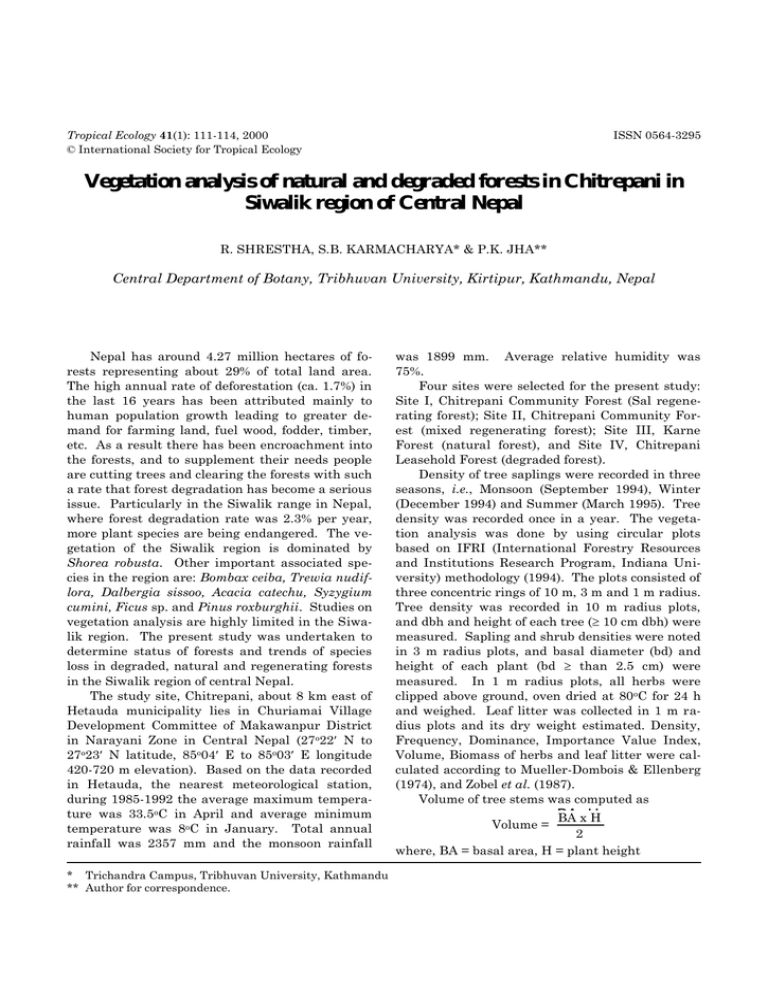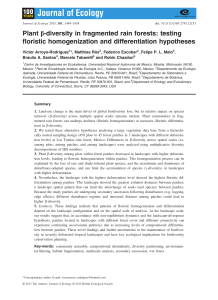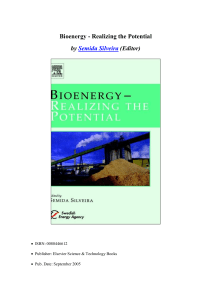
SHRESTHA, KARMACHARYA AND JHA
111
Tropical Ecology 41(1): 111-114, 2000
© International Society for Tropical Ecology
ISSN 0564-3295
Vegetation analysis of natural and degraded forests in Chitrepani in
Siwalik region of Central Nepal
R. SHRESTHA, S.B. KARMACHARYA* & P.K. JHA**
Central Department of Botany, Tribhuvan University, Kirtipur, Kathmandu, Nepal
Nepal has around 4.27 million hectares of forests representing about 29% of total land area.
The high annual rate of deforestation (ca. 1.7%) in
the last 16 years has been attributed mainly to
human population growth leading to greater demand for farming land, fuel wood, fodder, timber,
etc. As a result there has been encroachment into
the forests, and to supplement their needs people
are cutting trees and clearing the forests with such
a rate that forest degradation has become a serious
issue. Particularly in the Siwalik range in Nepal,
where forest degradation rate was 2.3% per year,
more plant species are being endangered. The vegetation of the Siwalik region is dominated by
Shorea robusta. Other important associated species in the region are: Bombax ceiba, Trewia nudiflora, Dalbergia sissoo, Acacia catechu, Syzygium
cumini, Ficus sp. and Pinus roxburghii. Studies on
vegetation analysis are highly limited in the Siwalik region. The present study was undertaken to
determine status of forests and trends of species
loss in degraded, natural and regenerating forests
in the Siwalik region of central Nepal.
The study site, Chitrepani, about 8 km east of
Hetauda municipality lies in Churiamai Village
Development Committee of Makawanpur District
in Narayani Zone in Central Nepal (27o22 N to
27o23 N latitude, 85o04 E to 85o03 E longitude
420-720 m elevation). Based on the data recorded
in Hetauda, the nearest meteorological station,
during 1985-1992 the average maximum temperature was 33.5oC in April and average minimum
temperature was 8oC in January. Total annual
rainfall was 2357 mm and the monsoon rainfall
* Trichandra Campus, Tribhuvan University, Kathmandu
** Author for correspondence.
was 1899 mm. Average relative humidity was
75%.
Four sites were selected for the present study:
Site I, Chitrepani Community Forest (Sal regenerating forest); Site II, Chitrepani Community Forest (mixed regenerating forest); Site III, Karne
Forest (natural forest), and Site IV, Chitrepani
Leasehold Forest (degraded forest).
Density of tree saplings were recorded in three
seasons, i.e., Monsoon (September 1994), Winter
(December 1994) and Summer (March 1995). Tree
density was recorded once in a year. The vegetation analysis was done by using circular plots
based on IFRI (International Forestry Resources
and Institutions Research Program, Indiana University) methodology (1994). The plots consisted of
three concentric rings of 10 m, 3 m and 1 m radius.
Tree density was recorded in 10 m radius plots,
and dbh and height of each tree ( 10 cm dbh) were
measured. Sapling and shrub densities were noted
in 3 m radius plots, and basal diameter (bd) and
height of each plant (bd than 2.5 cm) were
measured. In 1 m radius plots, all herbs were
clipped above ground, oven dried at 80oC for 24 h
and weighed. Leaf litter was collected in 1 m radius plots and its dry weight estimated. Density,
Frequency, Dominance, Importance Value Index,
Volume, Biomass of herbs and leaf litter were calculated according to Mueller-Dombois & Ellenberg
(1974), and Zobel et al. (1987).
Volume of tree stems was computed as
Volume =
BA
BA xx H
H
22
where, BA = basal area, H = plant height
112
VEGETATION ANALYSIS IN CHITREPANI
The aboveground biomass of tree species ( 10
cm dbh) was estimated following Brown & Iverson
(1992) :
Y = 1.276 + 0.034 (D2H)
where, Y = biomass (kg tree-1), D = diameter at
breast height, H = height in meter.
There were total 46 woody species (28 tree and
18 shrub) belonging to 27 different families. Site
III had the highest number (39) of species while
Site IV, degraded site, had the lowest number (10)
of species (Table 1). Sites I, II and IV each had five
shrub species. Site IV, degraded forest, had the
highest value for species loss (78.2% species), followed by Site I regenerating forest which lost 71.7%
species (Table 1). Shrestha et al. (1998) have reported 68% loss of plant species in degraded forest
as compared to natural forest in midhills of Nepal.
Distinctly, greater tree dbh was recorded at
Sites I and IV than at other sites except Site III
where Shorea robusta showed maximum dbh
range (10-189 cm) while the other species exhibited smaller dbh range. All plants at Site II
showed lower dbh range which indicate the regenerating state of the site (7 years old). The total
Table 1.
density of trees was found highest in Site II (1326
plants ha-1) and lowest in Site IV (23.9 plants ha-1)
(Table 1). All the three natural and regenerating
forest sites had a much higher tree density values
than the degraded forest site. Shorea robusta had
23.9 trees ha-1 in degraded forest while 141 trees
ha-1 occurred in natural forest. Aryal et al. (1999)
have reported 152 trees of S. robusta per hectare
in the Royal Bardia National Park of Nepal. Sites
I and IV were dominated by Shorea robusta and at
Site III (natural forest) it contributed more than
50% of the total density. At site II Terminalia bellirica and Wrightia arborea showed about three
fourth of the total density. Degraded forest had
lost 90.9% tree density whereas regenerating forest Site II gained density because of protection and
smaller size tree of Terminalia bellirica.
Total basal area of trees was highest in Site
III, natural forest (59.6 m 2 ha-1) and lowest in Site
IV, degraded site (11.4 m2 ha-1) (Table 1). All the
three natural and regenerating sites showed much
higher values than the degraded site. Here again
Shorea robusta accounted for the greater portion of
total basal area in Site III. While in Site II, Ter-
Occurrence of plant species, plant density, total basal area, plant biomass and species loss in
different forests of Nepal.
Regenerating Forest
Site I
Site II
Natural Forest
Site III
13
8
5
57
46-184
52.2
11099
795
1114
365
698
1154
818
237
71.7
78.4
4.36
21.9
13.5
15
10
5
1326
10-41
37.2
8154
827
1114
214
337
805
488
148
67.4
+105.1
37.6
54.1
58.2
39
23
16
264
10-189
59.6
8649
848
2238
467
807
144
210
88
15.2
-
Parameters
Total number of species
Trees
Shrubs
Density (plants ha-1)
dbh range (cm)
Total basal area (m2 ha-1)
Sapling density
Litterfall (kg ha-1)
March
December
3
-1
Bole volume (m ha )
Tree biomass (t ha-1)
Herb biomass (kg ha-1)
September
December
March
Species loss (%)
Tree density loss/gain (%)
Basal area loss (%)
Volume loss (%)
Tree biomass loss (%)
Degraded Forest
Site IV
10
5
5
23
30-135
11.4
1830
238
795
132
160
2735
635
354
78.2
90.9
80.0
71.7
80.1
SHRESTHA, KARMACHARYA AND JHA
minalia bellirica and Wrightia arborea accounted
for greater portion of total basal area. Aryal et al.
(1999) found 36.3 m2 ha-1 basal area in the Royal
Bardia National Park forest, out of that about 50%
was occupied by S. robusta.
Shorea robusta showed the highest importance
value index among the trees in all sites studied
except in Site II where Terminalia belliria showed
highest IVI. Broadly IVI followed the pattern similar to that of density and basal area. Thus, it
shows that though there are many species of trees
growing in this forest, sal is the dominant component and other species are associated and still
need to be established.
Aryal et al. (1999) reported greater density of
seedling-sapling compared to trees in Shorea robusta- Terminalia forest than in Shorea robusta
forest. The Shorea robusta seedling-sapling density was 13166 individual per hectare in the Royal
Bardia National Park, and 11099 in natural forest
at Chitrepani. However, the density of seedlingsapling was drastically reduced in destructed forest (Table 1). In Sites I and IV Cleistocalyx operculatus also showed increasing dominance, while
Wrightia arborea and Terminalia bellirica showed
similar trend in Site II. In Site III, Lagerstroemia
parviflora, Schima wallichii, Semecarpus anacardium and Wrightia arborea showed an increasing
dominance while all the remaining species showed
decreasing trend.
The biomass of herbaceous plants was highest
in September and lowest in March in all the sites
except natural forest where it was highest in December (Table 1). But the values in the degraded
site was much higher than in natural sites because
of open canopy allowing greater light to reach the
understorey and herbs had to compete less for
light and water (Gupta & Shukla 1991). Regenerating Site I had the highest value and natural
forest Site III had the lowest value which may be
because there were bigger plants so herbs had to
compete more in Site III. It can be seen that higher the number and size of larger plants in forests,
lower would be the biomass of herbs.
Leaf litter is considered a dominant component
of litterfall in sal forests (Singh & Singh 1992).
The leaf litter values were higher in March than in
December (Table 1) showing the semi-deciduous
nature and that maximum leaf fall occur from the
end of dry season (Herbohn & Congdom 1993).
The degraded site showed very low litter than the
natural sites.
113
Total tree volume was higher in the natural
forest (467 m3 ha-1) (Site III) which decreased to
132 m3ha-1 in degraded site. Thus the loss of
70.1% volume was recorded in degraded site compared to natural forest. However, the tree volume
values were 214 in another natural forest site and
365 m3 ha-1 in regenerating forest. The tree volume values in the present study were broadly
similar to that of the values calculated by different
methods (Dawkins 1961)
The aboveground live biomass (AGB) of trees
(Table 1) was also highest in natural forest Site III
(807 t ha-1) while Site IV, degraded site, had the
lowest value (160 t ha-1). Shorea robusta accounted for greater portion of AGB in both types of
forest except in Site II where Terminalia bellirica,
Wrightia arborea, Cleistocalyx operculatus and
Gmelina arborea had higher value. The value for
total aboveground biomass in present study was in
the mid of the range reported by Sejuwal (1994)
(1038 t ha-1) in sal forest of Royal Chitwan National Park, and Giri et al. (1999).
Shorea robusta was found to be the dominant
species of the plant community except in regenerating forest where Cleistocalyx operculatus, Terminalia bellirica and Wrightia arborea were found
dominant. Shorea robusta saplings were found
increasing in the forests where there were less
number of other species. Total volume and biomass of trees were higher in natural forests. It is
noted that degraded forest had lost 78.2% species,
90.9% loss of plant density, 80.0% basal area,
71.7% tree volume and 80.1% tree biomass compared to natural forest (Table 1).
Acknowledgements
The first author is grateful to Hills Leasehold
Forestry and Forage Development Project and
AFORDA for supporting and allowing to work under IFRI Research Program in the project area.
Thanks are also due to Head, Central Department
of Botany for facilities and Dr. K.K. Shrestha, Central Department of Botany, Tribhuvan University
for help in identification of plants.
References
Aryal, B., A. Giri, K.K. Shrestha, S.K. Ghimire & P.K.
Jha. 1999. Vegetation analysis of Shorea robusta
forests in the Royal Bardia National Park, Nepal.
Bangladesh Journal of Botany 28 : 35-46.
114
VEGETATION ANALYSIS IN CHITREPANI
Brown, S. & L.R. Iverson. 1992. Biomass estimates for
Tropical Forests. World Resource Review 4: 366-384.
Dawkins, H.C. 1961. Estimating total volume of some
Caribbean trees. Caribean Forestry 22: 62-63.
Giri, A., B. Aryal, B. Bhattarai, S.K. Ghimire, K.K.
Shrestha & P.K. Jha. 1999. Vegetation composition,
biomass production, regeneration in Shorea robusta
forests in the Royal Bardia National Park. Nepal.
Journal of Science and Technology 1: 47-56.
Gupta, O.P. & R.P. Shukla. 1991. The composition and
dynamics of associated plant communities of sal
plantations. Tropical Ecology 32: 296-309.
Herbohn, J.L. & R.A. Congdom. 1993. Ecosystem dynamics of disturbed and undisturbed sites in north
Queensland wet tropical rain forest : II Litterfall.
Journal of Tropical Ecology 9: 365-379.
IFRI. 1994. IFRI Data Collection Instruction Manual.
May 1994, Version 7. International Forestry Resources and Institutions (IFRI) Research Program.
Workshop in Political Theory and Policy Analysis,
Indiana University, Bloomington, Indiana, USA.
Mueller-Dombois, D. & H. Ellenberg. 1974. Aims and
Methods of Vegetation Ecology. John Wiley and
Sons, New York.
Sejuwal, M. 1994. Aboveground Biomass Estimation in
Tropical Forest of Royal Chitwan National Park.
M.Sc. Thesis submitted to Central Department of
Botany, Tribhuvan University, Kathmandu, Nepal.
Shrestha, S., P.K. Jha & K.K. Shrestha. 1998. Vegetation
of degraded, regenerating and natural forests in
Riyale, Kavrepalanchok, Nepal. Pakistan Journal of
Plant Science 4: 13-28.
Singh, J.S. & S.P. Singh. 1992. Forests of Himalayas:
Structure, Functioning and Impact of Man. Gyanodaya Prakashan, Nainital, India.
Zobel, D.B., P.K. Jha, M.J. Behan & U.K.R. Yadav.
1987. A Practical Manual for Ecology. Ratna Book
Distributors, Kathmandu, Nepal.





